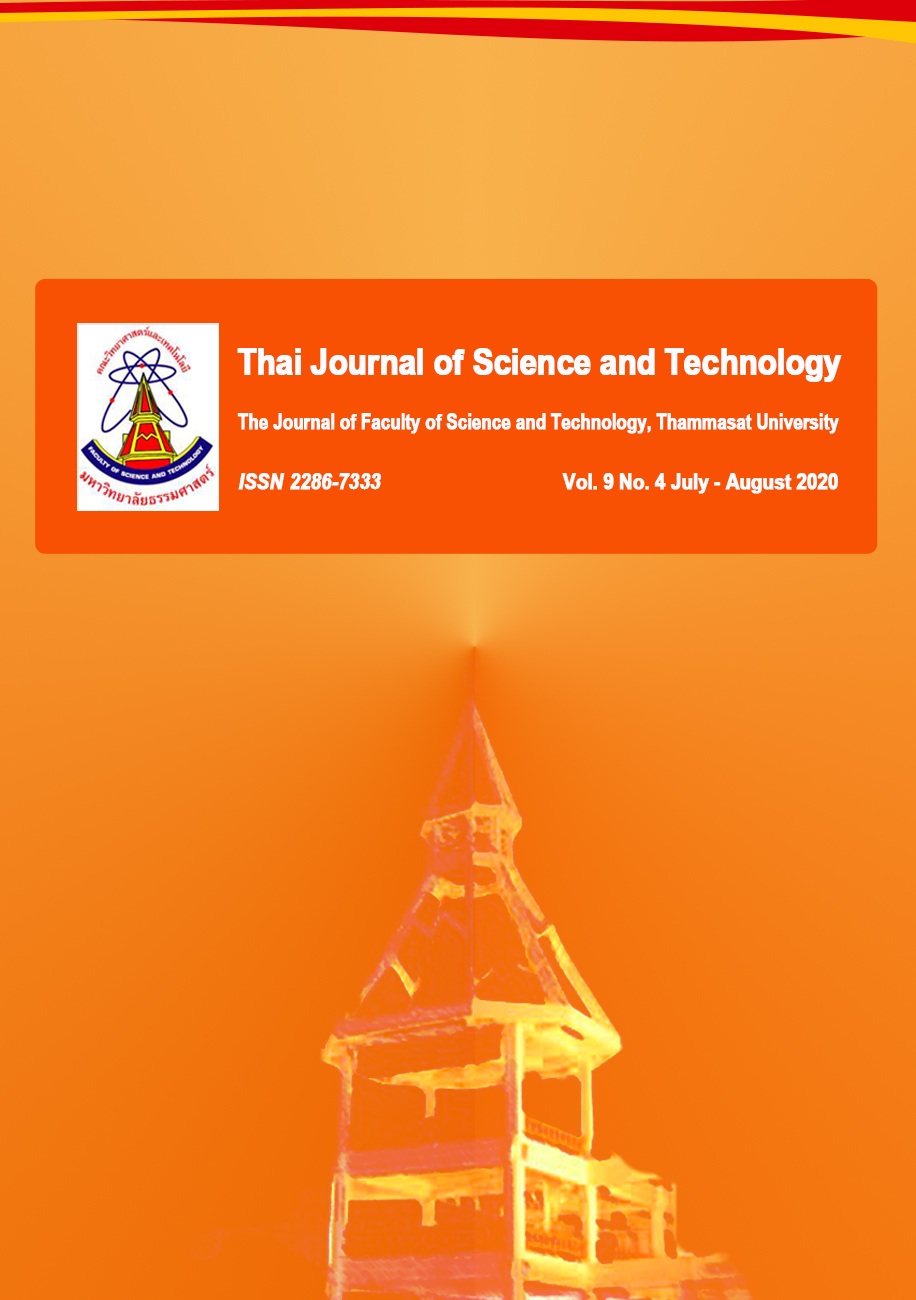Effects of Natural Carbon Sources and Temperature on Mycelium Cultivations of Lentinus squarrosulus (Mont.), Lentinus polychrous Lev., Pleurotus ostreatus (Jacq.ex Fr.) P. Kumm. and Volvariella volvacea (Bull.) Singer
Main Article Content
Abstract
Mycelial biomass can be used as an inoculum source for mushroom production and is a suitable source to produce useful substances. Temperature and carbon sources play a role in the production of biomass and bioactive compounds of mycelium cultivation. Thus, natural carbon sources including potato, sweet potato, and taro were used in this mycelium cultivation study. The purposes of this study were to investigate the effects of carbon sources and temperature on mycelium cultivation for four edible mushrooms. The growth of Lentinus squarrosulus (Mont.), Lentinus polychrous Lev., Pleurotus ostreatus (Jacq. ex Fr.) P. Kumm. and Volvariella volvacea (Bull.) Singer in culture media with various carbon sources at different temperatures were examined for their growth based on biomass and diameter. The results indicated that potato dextrose broth (PDB) was a suitable medium for growing P. ostreatus, V. volvacea and L. squarrosulus. The optimum temperature for the mycelial growth of V. volvacea, L. squarrosulus and P. ostreatus with maximum yields of 8.47±0.26 g/L, 6.44±0.30 g/L and 3.76±0.18 g/L, respectively, was 30±2oC after 7 days of incubation using a submerged cultivation. For L. polychrous, a sweet potato dextrose broth (SPDB) was a suitable medium for mycelial production (6.16±0.69 g/L) when cultivated at 35±2oC for 7 days. For mycelia cultivation on an agar medium, the maximum mycelium colony diameter of four edible mushrooms (6-9 cm) were obtained from the taro dextrose agar (TDA) medium at 3-8 days of incubation. Therefore, TDA was suitable and efficient mediums for cultivation of the four edible mushrooms.
Article Details
บทความที่ได้รับการตีพิมพ์เป็นลิขสิทธิ์ของคณะวิทยาศาสตร์และเทคโนโลยี มหาวิทยาลัยธรรมศาสตร์ ข้อความที่ปรากฏในแต่ละเรื่องของวารสารเล่มนี้เป็นเพียงความเห็นส่วนตัวของผู้เขียน ไม่มีความเกี่ยวข้องกับคณะวิทยาศาสตร์และเทคโนโลยี หรือคณาจารย์ท่านอื่นในมหาวิทยาลัยธรรมศาสตร์ ผู้เขียนต้องยืนยันว่าความรับผิดชอบต่อทุกข้อความที่นำเสนอไว้ในบทความของตน หากมีข้อผิดพลาดหรือความไม่ถูกต้องใด ๆ
References
Anike, F.N., Isikhuemhen, O.S., Blum, D. and Neda, H., 2015, Nutrient requirements and fermentation conditions for mycelia and crude exo-polysaccharides production by Lentinus squarrosulus, Adv. Biosci. Biotechnol. 6: 526-536.
Barakat, O.S. and Sadik, M.W., 2014, Mycelial growth and bioactive substance production of Pleurotus ostreatus in submerged culture, Int. J. Curr. Microbiol. Appl. Sci. 3: 1073-1085.
Chandrasekara, A. and Josheph Kumar, T., 2016, Roots and tuber crops as functional foods: A review on phytochemical constituents and their potential health benefits, Int. J. Food Sci. 2016: 1-15.
Chang, S.T. and Miles, P.G., 2004, Overview of the Biology of Fungi, pp. 53-92, In Mushrooms: Cultivation, Nutritional Value, Medicinal Effect, and Environmental Impact, CRC Press, New York.
de Souza Kirsch, L., de Macedo, A.J.P. and Teixeira, M.F.S., 2016, Production of mycelial biomass by the Amazonian edible mushroom Pleurotus albidus, Braz. J. Microbiol. 47: 658-664.
Giri, S., Biswas, G., Pradhan, P., Mandal, S.C. and Acharya, K., 2012, Antimicrobial activities of basidiocarps of wild edible mushrooms of west Bengal, India, Int. J. Pharmtech. Res. 4: 1555-1560.
Ibekwe, V.I., Azubuike, P.I., Ezeji, E.U. and Chinakwe, E.C., 2008, Effects of nutrient sources and environmental factors on the cultivation and yield of oyster mushroom (Pleurotus ostreatus), Pak. J. Nutr. 7: 349-351.
Klomklung, N., Karunarathna, S.C., Hyde, K.D. and Chukeatirote, E., 2014, Optimal conditions of mycelial growth of three wild edible mushrooms from northern Thailand, Acta Biol. Szeged. 58: 39-43.
Nwokoye, A.I., Kuforiji, O.O. and Oni, P.I., 2010, Studies on mycelial growth requirements of Pleurotus ostreatus (Fr.) Singer, J. Basic Appl. Sci. 10: 47-52.
Vahidi, H., Mojab, F. and Taghavi, N., 2006, Effects of carbon sources on growth and production of antifungal agents by Gymnopilus spectabilis, Iran J. Pharm. Res. 3: 219-222.
Wongjiratthiti, A. and Yottakot, S., 2017, Utilization of local crops as alternative media for fungal growth, Pertanika J. Trop. Agric. Sci. 40: 295-304.


